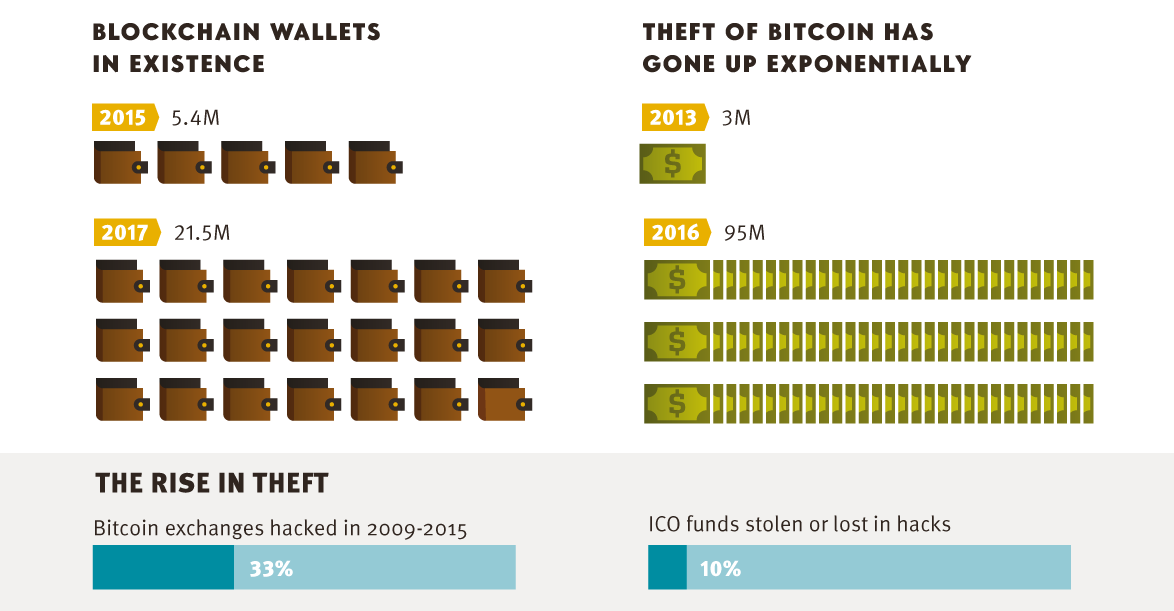Using complex cryptography and decentralized ledgers, a blockchain can operate independently from the world’s most powerful countries, corporations, and banking institutions. While this detachment from authority is extremely powerful, existing almost exclusively in the digital realm does have its drawbacks.
Preventing Crypto Theft
Today’s infographic from CryptoGo shows that as cryptocurrencies rise in prominence, so does its appeal to hackers, criminals, and other bad actors. With millions of dollars being stolen via crypto theft, investors and other dabblers in cryptocurrency must take precautions to protect their assets for the long haul.
Crypto theft comes in many different forms, and at least $225 million of cryptocurrency has been stolen as of mid-2017. There are various forms of crypto theft that have made this possible, including brute forcing, phishing, phone-porting, mining malware, and Ponzi schemes.
Strategies Used by Crypto Thieves
Here are the most prominent forms of crypto theft: Brute Forcing This is the form of hacking that most are familiar with. It involves automated software that simply tries different passwords until one works. Phone-Porting Using your phone number and a little “social engineering”, a hacker can convince a customer service rep that they are actually you. This allows them to reset your password and access your funds. Phishing In this case, a hacker will send you suspicious links through email or social media messages. By clicking on one of those links, malware is installed. Ponzi Schemes Multi-level marketing schemes that provide signing bonuses. These eventually collapse when prices change or signups stop. Once over, the thieves takes the money and run. Mining Malware Hackers hijack a computer’s power to mine cryptocurrency remotely.
Protecting Yourself
Crypto theft can be prevented by taking appropriate precautionary measures. These include using encrypted backups to hold private keys and other data, using proper anti-virus software for crypto, and opting for multi-factor authentication. Further, other general measures can also be taken to protect assets, such as holding only small amounts of cryptocurrency in hot wallets, using safety deposit boxes to store USB and private paper keys, turning off SMS authentication and email recovery options, and diversifying holdings through various exchanges.
on But fast forward to the end of last week, and SVB was shuttered by regulators after a panic-induced bank run. So, how exactly did this happen? We dig in below.
Road to a Bank Run
SVB and its customers generally thrived during the low interest rate era, but as rates rose, SVB found itself more exposed to risk than a typical bank. Even so, at the end of 2022, the bank’s balance sheet showed no cause for alarm.
As well, the bank was viewed positively in a number of places. Most Wall Street analyst ratings were overwhelmingly positive on the bank’s stock, and Forbes had just added the bank to its Financial All-Stars list. Outward signs of trouble emerged on Wednesday, March 8th, when SVB surprised investors with news that the bank needed to raise more than $2 billion to shore up its balance sheet. The reaction from prominent venture capitalists was not positive, with Coatue Management, Union Square Ventures, and Peter Thiel’s Founders Fund moving to limit exposure to the 40-year-old bank. The influence of these firms is believed to have added fuel to the fire, and a bank run ensued. Also influencing decision making was the fact that SVB had the highest percentage of uninsured domestic deposits of all big banks. These totaled nearly $152 billion, or about 97% of all deposits. By the end of the day, customers had tried to withdraw $42 billion in deposits.
What Triggered the SVB Collapse?
While the collapse of SVB took place over the course of 44 hours, its roots trace back to the early pandemic years. In 2021, U.S. venture capital-backed companies raised a record $330 billion—double the amount seen in 2020. At the time, interest rates were at rock-bottom levels to help buoy the economy. Matt Levine sums up the situation well: “When interest rates are low everywhere, a dollar in 20 years is about as good as a dollar today, so a startup whose business model is “we will lose money for a decade building artificial intelligence, and then rake in lots of money in the far future” sounds pretty good. When interest rates are higher, a dollar today is better than a dollar tomorrow, so investors want cash flows. When interest rates were low for a long time, and suddenly become high, all the money that was rushing to your customers is suddenly cut off.” Source: Pitchbook Why is this important? During this time, SVB received billions of dollars from these venture-backed clients. In one year alone, their deposits increased 100%. They took these funds and invested them in longer-term bonds. As a result, this created a dangerous trap as the company expected rates would remain low. During this time, SVB invested in bonds at the top of the market. As interest rates rose higher and bond prices declined, SVB started taking major losses on their long-term bond holdings.
Losses Fueling a Liquidity Crunch
When SVB reported its fourth quarter results in early 2023, Moody’s Investor Service, a credit rating agency took notice. In early March, it said that SVB was at high risk for a downgrade due to its significant unrealized losses. In response, SVB looked to sell $2 billion of its investments at a loss to help boost liquidity for its struggling balance sheet. Soon, more hedge funds and venture investors realized SVB could be on thin ice. Depositors withdrew funds in droves, spurring a liquidity squeeze and prompting California regulators and the FDIC to step in and shut down the bank.
What Happens Now?
While much of SVB’s activity was focused on the tech sector, the bank’s shocking collapse has rattled a financial sector that is already on edge.
The four biggest U.S. banks lost a combined $52 billion the day before the SVB collapse. On Friday, other banking stocks saw double-digit drops, including Signature Bank (-23%), First Republic (-15%), and Silvergate Capital (-11%).
Source: Morningstar Direct. *Represents March 9 data, trading halted on March 10.
When the dust settles, it’s hard to predict the ripple effects that will emerge from this dramatic event. For investors, the Secretary of the Treasury Janet Yellen announced confidence in the banking system remaining resilient, noting that regulators have the proper tools in response to the issue.
But others have seen trouble brewing as far back as 2020 (or earlier) when commercial banking assets were skyrocketing and banks were buying bonds when rates were low.

















